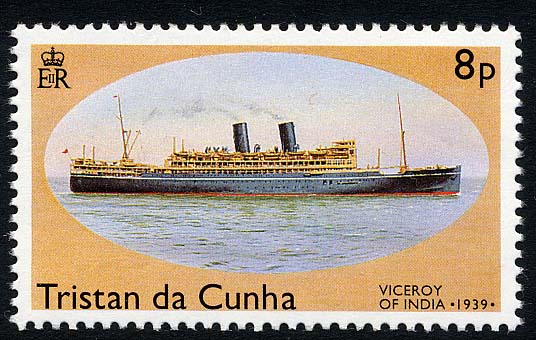
Name: RMS Viceroy of India
Owner: The Peninsular and Oriental Steam Navigation Company Ltd. (P & O)
Port of Registry: Great Britain
Route: London - Bombay and cruising
Builder: Alexander Stephen & Sons of Glasgow
Yard number: 519
Laid down: April 1927
Launched: 15 September 1928
Christened: By Dorothy, Countess of Halifax, the wife of the Viceroy of India E. F. L. Wood, 1st Earl of Halifax
Maiden voyage: 7 March 1929
Homeport: Glasgow
Identification: Official Number: 160238
Signal letters: LCTV
Call sign: GLVX
Fate: Sank by German U-boat U-407 November 1942.
General characteristics
Class and type: Ocean liner
Tonnage: 19,648 gross tons
10,069 net tons
9,180 tons deadweight
Length: 586.1 feet
612.3 feet overall
Beam: 76.2 feet
Draught: 28.3 feet
Depth: 41.5 feet
Decks: 5
Installed power: BOILERS:
6 water tube, 400lb steam pressure. Steam pressure 700 degrees, super heated F.D. Oil Fuel.
ENGINES :
Builders: Alexander Stephen and Sons Ltd
Two steam turbo-generators, each 900 kW., 2,690/3,110 r.p.m. 3 phase 2,720 volts
2 electrical shaft motors on screw shaft, each 8,500 shaft horse power., 109 r.p.m. 3 phase, 3,150 volts.
At reduced powers of 11,600 shaft horse power and under, only one turbo-generator was required for supplying power to both motors, thus maximum fuel economy is obtained. Variation of propeller speed in either direction is achieved by changing the turbine speed.
19,000 shaft horse power by British Thompson-Houston Co. Ltd. Rugby, Warwickshire
Propulsion: Twin screw
Speed: 19 knots
Capacity: Passengers:
415 1st class passengers
258 2nd class passengers
Cargo:
217,752 cubic feet (6,165 cubic metres)
Crew: 413 crewmembers total:
14 officers
19 petty officers
59 seamen
18 engineers
53 firemen
248 pursers and stewards
1 surgeon and 1 assistant
Notes: Paintwork:
Hull black with white band
red boot-topping
upper works stone
funnels black.
Appropriately RMS Viceroy of India was launched on 15 September 1928 by Dorothy, Countess of Halifax, the wife of the Viceroy of India, E. F. L. Wood, 1st Earl of Halifax. The name had been changed from "Taj Mahal" to avoid offending Indians, particularly Muslims, who regard the Taj Mahal as a sacred mausoleum.
Fitting out commenced at Shieldhall Wharf, Glasgow, but unfortunately on 8 January 1929 she was damaged amidships by the 7,131 tons Donaldson Lines cargo ship Corinaldo which was attempting to dock in poor visibility. However, by 17 February she was ready for her sea trials, during which she averaged 19.6 knots.
The Viceroy was delivered to P & O on 7 March and made her maiden voyage on the Indian Mail service. However, the beautifully appointed liner was ideal for the leisure cruise market, particularly with the unusual amenity of an indoor swimming pool, and therefore was used as a cruise ship every year until the outbreak of the Second World War.
In February 1939 as part of a cruise of the South Atlantic she was the first P & O liner to call at the island of Tristan da Cunha.
But without doubt her finest achievement was in September 1932 when she recorded a new record time between London and Bombay of 17 days, 1 hour and 42 minutes.
Viceroy of India was in service for little more than fourteen years from launching to destruction, but in that period she figured in many significant maritime incidents.
On 23 November 1929 she rescued 25 crew members from the Italian steamer Maria Luisa which was sinking in the eastern Mediterranean.
In September 1930 she was on standby when the crew of the Greek cargo ship Theodoros Bulgararis had to be transferred to another vessel after its cargo of grain shifted in storms in the Bay of Biscay.
Incredibly, less than three months later, on 31 December 1930, the Viceroy was again called to the aid of the Theodoros Bulgararis in the Bay of Biscay, and rescued all of the crew. On this occasion the Greek vessel was lost.
On 5 September 1935 the Viceroy rescued 241 passengers from the Cunard White Star liner Doric after her collision with the French steamer Formigny off Cape Finisterre.
On 11 August 1940 279 passengers were rescued from another Cunard White Star liner, Ceramic, after her collision with the cargo liner Testbank approaching Cape Town.
In November 1940 the Viceroy returned to the River Clyde for conversion to a troopship.
Exactly two years later, while returning from Algiers during the North Africa campaign she encountered the German U-boat U-407 approximately 30 miles north of Oran. The Viceroy was torpedoed and sunk. Fortunately only four crew members were lost out of a total of 432 crew and 22 passengers. Survivors were picked up by the Royal Navy destroyer HMS Boadicea.
From Wikipedia
Tristan SG556
